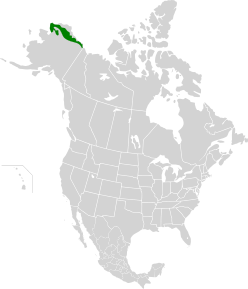Arctic foothills tundra facts for kids
Quick facts for kids Arctic Foothills Tundra |
|
|---|---|

Arctic National Wildlife Refuge, looking south toward the Brooks Range
|
|

1104. Arctic Foothills Tundra
|
|
| Ecology | |
| Realm | Nearctic |
| Biome | Tundra |
| Borders | Arctic coastal tundra, Brooks-British Range tundra, Interior Alaska-Yukon lowland taiga and Northwest Territories taiga |
| Bird species | 64 |
| Mammal species | 31 |
| Geography | |
| Area | 123,512 km2 (47,688 sq mi) |
| Country | United States |
| State | Alaska |
| Rivers | Noatak River, Colville River |
| Conservation | |
| Conservation status | Relatively Stable/Intact |
| Global 200 | Yes |
| Habitat loss | 0% |
| Protected | 67.8% |
The Arctic Foothills Tundra is a special natural area in the far north of North America. It's found inland from the northern coast of Alaska. This region is a type of tundra where the ground is always frozen, called permafrost. The average temperature here is always below freezing!
Contents
Where is the Arctic Foothills Tundra?
This ecoregion is a hilly land located between two other areas. To the north, you'll find the wet and marshy Arctic coastal tundra. To the south are the tall Brooks Range mountains. The Arctic Foothills Tundra stretches from the Chukchi Sea in the west, across northern Alaska, all the way to the border of Canada's Yukon Territory. The only place with trees in this area is the Noatak River valley.
Plants of the Tundra
The main plants you'll see here are scrubby cottongrass (Eriophorum vaginatum) and stiff sedge (Carex bigelowii). There are also many shrubs, like dwarf birch (Betula nana), crowberry (Empetrum nigrum), and Labrador tea (Rhododendron subarcticum). You might also find tasty lingonberries (Vaccinium vitis-idaea) growing here.
Animals of the Tundra
The Colville River is a very important route for animals. Many creatures, including moose, use it to travel. It's also a breeding spot for amazing birds like the gyrfalcon, peregrine falcon, and rough-legged hawk. Many other waterbirds also call this ecoregion home.
You'll find large mammals here too. These include moose (Alces alces) and caribou (Rangifer tarandus). Predators like the brown bear (Ursus arctos) and wolf (Canis lupus) raise their young in this area. Smaller mammals include the Alaskan hare (Lepus othus) and the Arctic ground squirrel (Spermophilus parryi).
Protecting the Tundra
This ecoregion is mostly untouched by human activity. However, the Dalton Highway and the Trans-Alaska Pipeline cross through it. These can sometimes make it harder for wildlife to migrate. Luckily, a large part of the eastern side of this ecoregion is protected within the Arctic National Wildlife Refuge. This helps keep the land and its animals safe.

